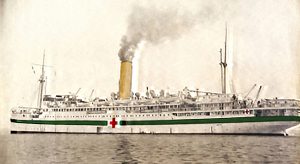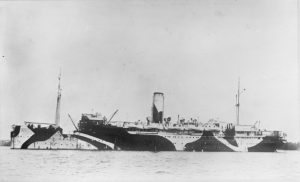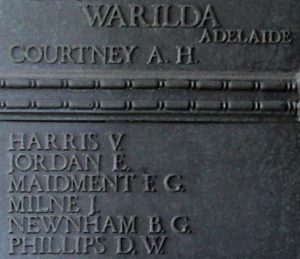Military unit: Mercantile Marine, HMAT Warilda
Date & place of birth: 20 August 1893 at Andersons Road, Southampton
Date & place of death: 3 August 1918, aged 24, in the English Channel
John Milne was an engineer on board the hospital ship, HMAT Warilda when she was sunk by a torpedo attack in the English Channel.
Family
John Milne was born at 6 Andersons Road, Southampton on 20 August 1893, the youngest surviving child of George Milne (1854–1927) and his wife Barbara née Munro (1859–1932).
George Milne was born at Rothes in in Morayshire, Scotland before his family moved to the small village of Urquhart, approximately five miles east of Elgin, where, on 28 December 1882, aged 28, he married 23-year old Barbara Munro. On the marriage certificate, his occupation is recorded as “ship’s carpenter” and his home address as Bridge Road, Southampton
George and Barbara’s first child, James Gordon Milne, was born at Burniestrype, a hamlet a few miles from Urquhart, on 16 October 1883. On the birth register, George is now shown as resident at 6 Andersons Road, Southampton, and employed as a “ship’s carpenter, journeyman”.
At some time in the next few years, the rest of the family moved to 6 Andersons Road, Southampton, where a daughter, Barbara was born on 1 January 1891 followed by John on 20 August 1893. A fourth child, Annie was born a year later but, sadly, she died in March 1895, from the effects of diarrhoea, aged just seven months.
The family cannot be traced on the 1891 census, but in 1901 Barbara is living at 7 Andersons Road, Southampton with her three children, although George was not in the family home at the time of the census. The eldest child, James, aged 17, was employed as a plumber.
Ten years later, in March 1911, Barbara was still living at 7 Andersons Road, and George was again absent; John, aged 17, was living with his mother and was now employed as an engineer’s apprentice, at the “railway docks”. The census also records that Barbara and George had had 4 children, one of whom had died. James, now employed as a ship’s plumber, had married, but was still living at 7 Andersons Road (which appeared to be divided into two dwellings), with his wife and two children. The younger Barbara was staying with friends in Highcliffe Avenue; aged 20, she described herself as “of private means”.
Masonic career
On 14 November 1917, John Milne (aged 24) was initiated into Beach Lodge No 2955 at Southampton. He was passed to the Second Degree on 10 April 1918 and raised to the degree of a Master Mason on 8 May.
Service in the Merchant Navy
Details of John’s early career in the Merchant Navy are rather sketchy. He joined the Royal Mail Steam Packet Company on 8 January 1914, aged 20 and initially served on the RMS Arlanza, a 14,622 ton ocean liner launched in 1911, before joining the RMS Carnavonshire.
The 9,406 ton Carnavonshire was launched in 1914 for the Royal Mail’s Shire Line. Her maiden voyage started on 7 May 1914 from London to the Far East and on the outbreak of the First World War in August 1914 she was requisitioned to transport troops from the China garrison at Chinwangtao (now Qinhuangdao) to Europe. She was used for various trooping duties during the war, including bringing 1,200 American troops to the UK in May 1917.
HMAT Warilda
On 23 May 1917, John joined the crew of the hospital ship, Warilda as Third Engineer. The Warilda was a 7,713-ton vessel, built in 1911 for the Adelaide Steamship Company. Originally used on the East-West Australian coastal service, at the outbreak of the war she was converted into a troop ship and used to transport Australian troops to North Africa and Europe.
 In July 1916, the Warilda was again converted, this time into a hospital ship. The medical staff were British, from the Royal Army Medical Corps, although at this time the crew remained Australian, under the command of Captain James Sim. After helping to evacuate casualties from the failed assault on Gallipoli, in May 1917 she was recalled to Britain where her Australian crew were replaced with British seamen, although most of the Australian officers and engineers remained with the ship.
In July 1916, the Warilda was again converted, this time into a hospital ship. The medical staff were British, from the Royal Army Medical Corps, although at this time the crew remained Australian, under the command of Captain James Sim. After helping to evacuate casualties from the failed assault on Gallipoli, in May 1917 she was recalled to Britain where her Australian crew were replaced with British seamen, although most of the Australian officers and engineers remained with the ship.
From May 1917 onwards, the Warilda operated a shuttle service across the English Channel bringing casualties from Le Havre in France to Southampton. By August 1918, she had made over 180 trips from Le Havre to Southampton, carrying approximately 80,000 patients.

After several attacks on hospital ships by German U-boats, in late 1917 Britain abandoned its practice of having these ships painted white with a prominent red cross, showing their lights at night and carrying no armaments. The hospital ships were re-classified as “ambulance transports”, painted in camouflage colours and armed with a 4.5 inch gun, mounted at the stern.
In early 1918, the Warilda was involved in two potential disasters. In February, she was struck by a torpedo which failed to explode. On 24 March, she collided with the French steamer Petingaudet near the Isle of Wight. The Petingaudet was seriously damaged and had to be towed to Stokes Bay where she was beached. The Warilda was badly damaged in the collision but managed to reach Southampton where she was repaired before returning to service. An Admiralty enquiry subsequently found that the collision was caused by the negligent navigation of the Hospital Ship.
Death and commemoration
On the evening of 2 August 1918, Warilda left Le Havre bound for Southampton, escorted by two destroyers, carrying 660 wounded soldiers with a medical staff of 60 and 115 crew members. At about 1:30 in the morning of 3 August, the officer on watch sighted a submarine on the surface off the starboard bow. Warilda turned to ram the submarine, which fired a torpedo hitting the Warilda on the starboard side, exploding in the engine room. Seven men in the engine room, including Third Engineer John Milne, were killed instantly. The explosion also killed 102 soldiers and nurses in a ward directly above where the torpedo hit.
With the starboard engine out of action and the port engine still running but out of control, Warilda began to turn in circles, settling deeper in the water. Attempts to launch the lifeboats were hampered by the movement of the ship, with at least two capsizing before they hit the water, with 14 passengers drowning as they were thrown into the sea. Fortunately, the two destroyers were quickly on the scene and were able to rescue the survivors. One of the destroyers attempted to take Warilda in tow without success and, at 4:10 a.m., two and a half hours after the torpedo attack, she sank stern first.
Out of the total of over 800 persons on board, 123 lost their lives as a result of the attack.
John Milne’s obituary in De Ruvigny’s Roll of Honour says:
Chief Engineer Young told his father that his son was on watch in the engine room when the ship was struck, and was literally blown to pieces. He had always proved him a most trustworthy and reliable officer, and one of great promise, and he felt his loss most keenly. He was respected by the whole of the ship’s officers.

John Milne and the other six casualties from the engine room are remembered on the Tower Hill Memorial, which commemorates men of the Merchant Navy and Fishing Fleets who gave their lives and have no grave but the sea.
John and several of his fellow crew members are also commemorated on the Cenotaph in Southampton’s Watts Park.
Warilda sank about 32 miles SSW of the Owers Light Vessel, at 50° 10’N, 0° 13’W. Her wreck still lies in the English Channel and is a popular site for divers to explore. U-boat UC 49 which launched the torpedo, attacked and damaged two more merchant vessels before she was sunk off Start Point in Devon by depth charges from HMS Opossum on 8 August 1918, with the loss of all hands.
Sources
Ancestry.co.uk
1901 England Census
1911 England Census
De Ruvigny’s Roll of Honour, 1914-1919
United Grand Lodge of England Freemason Membership Records, 1751–1921
Scotland’s People
Statutory registers: Births
Statutory registers: Marriages
Australian War Memorial: Milward, Jennifer (1 August 2014) SS Warilda: troopship, hospital ship, ambulance transport, wreck
BBC News (24 October 2018) Interactive map reveals World War One wreck sites
CWGC Casualty Details: Milne, John
Flotilla Australia: Warilda
Great War Forum: Third Engineer John Milne & HMAT Warilda
Hampshire Advertiser. 17 August 1918. Deaths
Masonic Roll of Honour: Third Engineer John Milne
The National Archives:
ADM 137/3420. Loss of H.M. Hospital Ship (Ambulance transport) Warilda
BT 110/841/34. Ship Warilda, official number: 122739.
BT 165/1821. Extracted Logs: Ship’s Name Warilda Official Number 122739
Royal Fleet Auxiliary Historical Society: RFA Steady (Salvage of the Petingaudet)
The Ships List: Carnarvonshire 1914
Southampton Cenotaph: John Milne
Uboat.net: Ships hit during WWI: Warilda
Vickery, James. Coast to Coast: The Great Australian Coastal Liners (2007) pp.65, 68-69
We Will Remember Them (Tower Hill Memorial): Warilda
Wikipedia:
Wrecksite:
Photograph credits
Warilda: The Sinking of HMAT Warilda
Warilda in 1917: Australian War Memorial
Tower Hill Memorial: Warilda